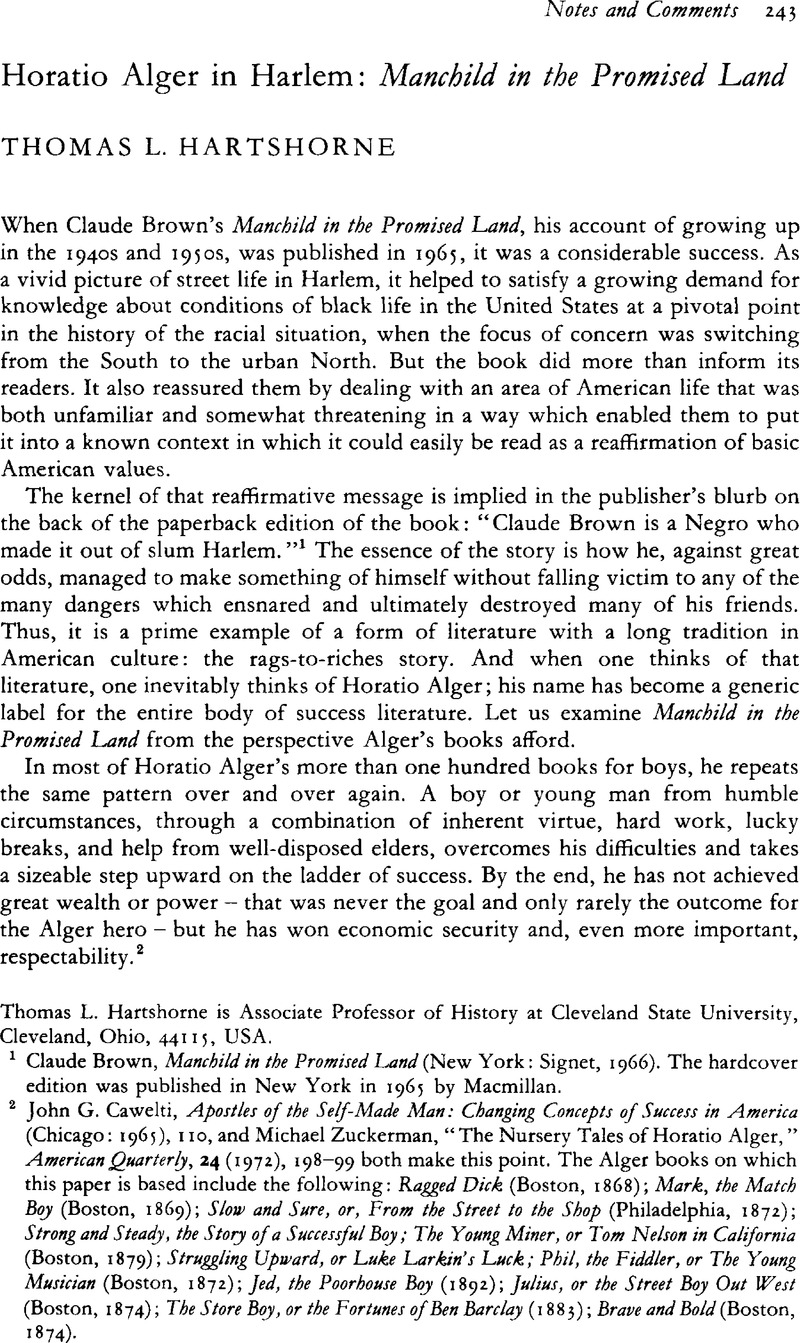Article contents
Horatio Alger in Harlem: Manchild in the Promised Land
Published online by Cambridge University Press: 16 January 2009
Abstract

- Type
- Notes and Comment
- Information
- Copyright
- Copyright © Cambridge University Press 1990
References
1 Brown, Claude, Manchild in the Promised Land (New York: Signet, 1966). The hardcover edition was published in New York in 1965 by Macmillan.Google Scholar
2 Cawelti, John G., Apostles of the Self-Made Man: Changing Concepts of Success in America (Chicago: 1965), 110Google Scholar, and Zuckerman, Michael, “The Nursery Tales of Horatio Alger,” American Quarterly, 24 (1972), 198–99CrossRefGoogle Scholar both make this point. The Alger books on which this paper is based include the following: Ragged Dick (Boston, 1868)Google Scholar; Mark, the Match Boy (Boston, 1869)Google Scholar; Slow and Sure, or, From the Street to the Shop (Philadelphia, 1872)Google Scholar; Strong and Steady, the Story of a Successful Boy; The Young Miner, or Tom Nelson in California (Boston, 1879)Google Scholar; Struggling Upward, or Luke Larkin's Luck; Phil, the Fiddler, or The Young Musician (Boston, 1872)Google Scholar; Jed, the Poorhouse Boy (1892)Google Scholar; Julius, or the Street Boy Out West (Boston, 1874)Google Scholar; The Store Boy, or the Fortunes of Ben Barclay (1883)Google Scholar; Brave and Bold (Boston, 1874).Google Scholar
3 See Baker, Houston A. Jr., “The Environment as Enemy in a Black Autobiography: Manchild in the Promised Land,” Phyhn, 32 (1971), 55–59Google Scholar. One should also note that the very last paragraphs of the book, the author's closing words to his readers, are a kind of recapitulation of the feelings he had as a boy, regarding the wonderful and exciting world of the Harlem streets.
4 Brown, , 21.Google Scholar
5 Ibid., 155.
6 For example, this happens to Ragged Dick, Mark, the Match Boy, and Phil, the Fiddler, the respective heroes of the books by those names. In fact, a large part of the aid which the benevolent elder provides the hero consists of making him aware that a better life is a real possibility.
7 Brown, , 271.Google Scholar
8 Ibid., 421.
9 Ibid., 424. In his review of Manchild in the Promised Land, Paul Goodman also stressed the educational value of Brown's street experiences. See “Growing Up Black,” New York Review of Books, 25 08 1965.Google Scholar
10 Scharnhorst, Gary with Bales, Jack, The Lost Life of Horatio Alger, Jr. (Bloomington: Indiana University Press, 1985), 127 and 149–65Google Scholar, and Scharnhorst, Gary, Horatio Alger, Jr., (Boston: Twayne, 1980), passim.Google Scholar
11 Brown, , 300.Google Scholar
12 For a particularly scathing example see Miller, Warren, “One Score in Harlem,” Saturday Review, 28 08 1965.Google Scholar
13 Nat Hentoff makes this point in his review of Manchild, “Sprung from the alley, a rare cat,” New York Herald Tribune Book. Week, 22 08 1965.Google Scholar
- 1
- Cited by




